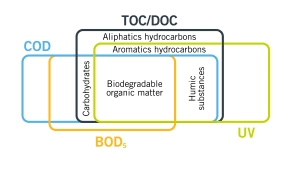UV254, TOC, DOC, BOD and COD all provide measures of different aspects of the organic content in a water sample. Each of these parameters possesses a certain bias due to the nature of the particular test method:
ABSORBANCE AT 254 nm (UV254)
UV254 is a measurement of the amount of light absorbed by organic compounds, specifically aromatic, in a water sample. Ultraviolet light at the 254 nm wavelength is passed through a quartz cell containing the sample water. The intensity of the attenuated light is measured with a sensor and divided by a pure water measurement before a logarithm is calculated. The measurement is reported as absorbance per path length (abs/cm). UV254 can be measured with a portable test meter or in real-time with an online analyzer.
TOTAL ORGANIC CARBON (TOC)
Total Organic Carbon or TOC is a measurement of the amount of organic carbon present in water. The most common methods for Total Organic Carbon analysis are Method 415.1 (Combustion or Oxidation) and Method 415.2 (UV Promoted, Persulfate Oxidation). The test involves converting all organic carbon in a water sample to carbon dioxide (CO2) by utilizing heat and oxygen, chemical oxidants or UV radiation. The resultant CO2 concentration is measured with an infrared analyzer and reported as organic carbon (mg/L). The test takes 5-10 minutes to yield results in the lab, with continuous on-line analyzers also available.
DISSOLVED ORGANIC CARBON (DOC)
Dissolved Organic Carbon or DOC is a measurement of the amount of organic matter in water that can be passed through a filter, commonly 0.45 µm. A common method for Dissolved Organic Carbon analysis is Method 415.1. The procedure for analyzing DOC requires that the samples first be passed through a 0.45 µm filter. The test involves converting organic carbon to carbon dioxide (CO2) through oxidation (Combustion, UV promoted or Persulfate oxidation). The concentration of CO2 generated is measured using an infrared analyzer and reported as organic carbon (mg/L).
CHEMICAL OXYGEN DEMAND (COD)
Chemical Oxygen Demand or COD is a measurement of the oxygen required to oxidize soluble and particulate organic matter in water. A common method for Chemical Oxygen Demand analysis is Method 410.4. The method involves using a strong oxidizing chemical, potassium dichromate Cr2O72-, to oxidize the organic matter in solution to carbon dioxide and water under acidic conditions. Often, the test also involves a silver compound to encourage oxidation of certain organic compounds and mercury to reduce the interference from oxidation of chloride ions. The sample is then digested for approximately 2 hours at 150°C. The amount of oxygen required is calculated from the quantity of chemical oxidant consumed.
BIOCHEMICAL OXYGEN DEMAND (BOD)
Biochemical Oxygen Demand or Biological Oxygen Demand, is a measurement of the amount of dissolved oxygen (DO) that is used by aerobic microorganisms when decomposing organic matter in water. The most common approved laboratory method for determination of Biochemical Oxygen Demand is Standard Methods 5210B. A sample is first analyzed and conditioned to ensure favourable growth conditions for bacteria, which may include adjustment for pH, neutralization of residual chlorine, and/or reduction of DO in supersaturated samples. The sample is then diluted and the appropriate amount of seed bacteria added. The initial dissolved oxygen content is recorded and the sample is then incubated for 5 days at 20°C. After the 5 day period, the sample is removed from the incubator and the final dissolved oxygen reading is taken. BOD is calculated from the DO depletion and volume of sample used following the formula: BOD5 = BOD mg/L = [(IDO -DO5) – seed correction] x dilution factor
UV SPECTRAL ABSORBANCE FOR BOD, COD, TOC AND DOC ONLINE ORGANICS MEASUREMENT
Traditional BOD, COD, TOC and DOC parameters are time consuming and expensive tests for measuring organics in water as per above, making them impractical to use for process control applications. Fortunately, spectrophotometry which is the use of UV-Vis light across multiple wavelengths can be used to provide an affordable and simple real-time surrogate measurement – enabling new opportunities for water and wastewater treatment operators to better control their processes.
Since the absorbance of matter in water is directly proportional to the concentration (see Beer’s Law), a correlation can be made to any aggregate organics parameter. This therefore allows the use of spectral analysis for reliable and affordable, real-time organics monitoring. Site-specific calibrations in combination with laboratory data can also be made by collecting UV-Vis spectral data, providing an even more accurate, robust and reliable correlation for the parameter of interest, such as BOD, COD, TOC or DOC in real-time. UV-Vis instruments also have the added benefit of being able to characterize the nature of the organics in a water sample, something that cannot be accomplished with a one dimensional TOC analyzer or other wet chemistry analyzer.
Given their affordability, ease of use and accuracy, UV-Vis instruments provide the most practical testing solution for measuring organics in water. Discover more about our instruments for real-time BOD, COD, TOC and DOC monitoring here.
GO BACK TO BLOG
![]()

